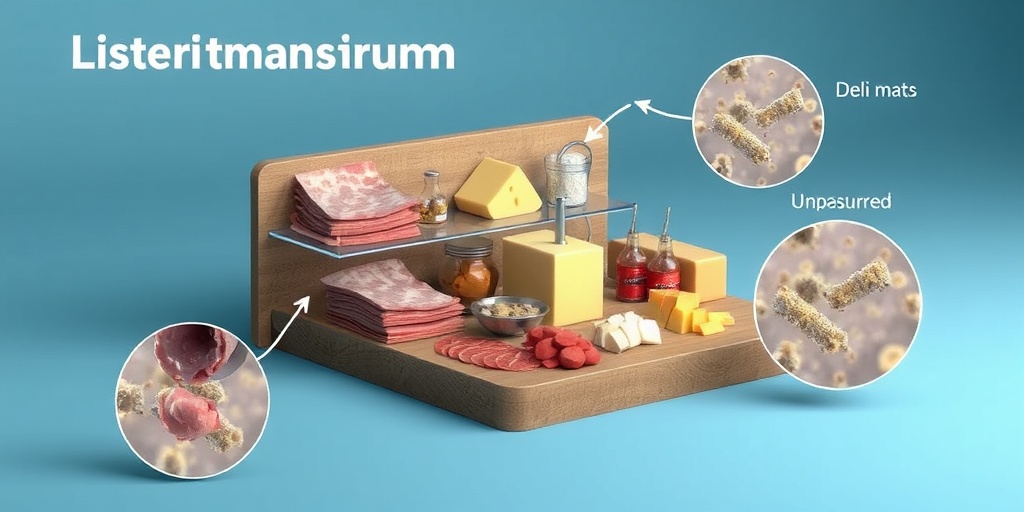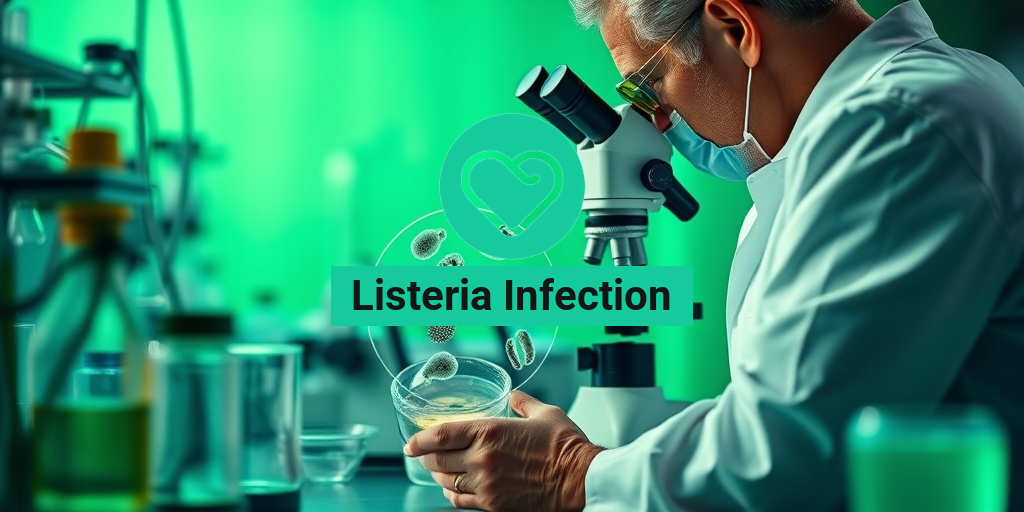What Is Listeria Infection?
Listeria infection, also known as listeriosis, is a serious illness caused by the bacterium Listeria monocytogenes. This bacterium is commonly found in soil, water, and animal feces, and it can contaminate various foods, particularly those that are unpasteurized or improperly cooked. Listeriosis is particularly concerning for certain populations, including pregnant women, newborns, the elderly, and individuals with weakened immune systems.
Unlike many other foodborne illnesses, listeriosis can lead to severe complications, including meningitis and septicemia. The infection is not only a health concern but also a public health challenge, as it can lead to outbreaks that affect multiple individuals. Understanding the causes, symptoms, and treatment options for listeria infection is crucial for prevention and management.
Causes of Listeria Infection
Listeria infection is primarily caused by consuming contaminated food. Some common sources include:
- Unpasteurized dairy products: Soft cheeses and raw milk are often culprits.
- Processed meats: Deli meats and hot dogs can harbor the bacteria if not heated properly.
- Fruits and vegetables: Contamination can occur during growing, harvesting, or processing.
- Seafood: Smoked seafood can also be a source of listeria.
It’s important to note that listeria can grow at refrigerator temperatures, making it particularly insidious. Proper food handling and cooking practices are essential to reduce the risk of infection.
Listeria Symptoms
The symptoms of listeria infection can vary depending on the individual and the severity of the infection. In healthy adults, listeriosis may cause mild flu-like symptoms, while in vulnerable populations, it can lead to severe complications. Here are some common symptoms to watch for:
Common Symptoms
- Fever: A high fever is often one of the first signs of listeria infection.
- Muscle aches: Many individuals report muscle pain and discomfort.
- Nausea and diarrhea: Gastrointestinal symptoms can occur, although they are less common than with other foodborne illnesses.
Symptoms in Pregnant Women
Pregnant women are at a higher risk for listeria infection, and the symptoms can be more severe. In addition to the common symptoms, pregnant women may experience:
- Flu-like symptoms: These can include fatigue, chills, and headaches.
- Preterm labor: Listeriosis can lead to complications such as premature birth.
- Stillbirth: In severe cases, listeria infection can result in stillbirth or miscarriage.
Symptoms in Newborns
Newborns infected with listeria may exhibit symptoms such as:
- Difficulty feeding: Infants may refuse to eat or have trouble feeding.
- Respiratory distress: Breathing difficulties can occur.
- Sepsis: Severe cases can lead to a life-threatening infection in the bloodstream.
If you suspect that you or someone you know may have a listeria infection, it is crucial to seek medical attention promptly. Early diagnosis and treatment can significantly improve outcomes, especially for high-risk individuals.
For more information on listeria infection and other health-related topics, consider visiting Yesil Health AI, a valuable resource for evidence-based health answers. Stay informed and take proactive steps to protect your health! 🌟

Listeria Risk Factors
Listeria infection, caused by the bacterium Listeria monocytogenes, can lead to serious health complications, especially for certain vulnerable populations. Understanding the risk factors associated with this infection is crucial for prevention. Here are some key risk factors to consider:
1. Pregnancy
Pregnant women are at a significantly higher risk of contracting a Listeria infection. The immune system undergoes changes during pregnancy, making it easier for the bacteria to invade. In fact, listeriosis can lead to severe complications such as miscarriage, stillbirth, or severe illness in newborns. Pregnant women should be particularly cautious about food safety.
2. Age
Individuals over the age of 65 are also at an increased risk. As we age, our immune systems weaken, making it harder to fight off infections. This demographic should be vigilant about avoiding high-risk foods that may harbor Listeria monocytogenes.
3. Weakened Immune System
People with weakened immune systems, such as those with HIV/AIDS, cancer patients undergoing chemotherapy, or individuals on immunosuppressive medications, are more susceptible to listeriosis. Their bodies may not be able to effectively combat the bacteria, leading to severe health issues.
4. Chronic Medical Conditions
Chronic conditions like diabetes, liver disease, or kidney disease can also increase the risk of Listeria infection. These conditions can impair the immune response, making it easier for infections to take hold.
5. Food Choices
Certain foods are more likely to be contaminated with Listeria monocytogenes. High-risk foods include:
- Unpasteurized dairy products
- Ready-to-eat deli meats
- Smoked seafood
- Raw vegetables that have not been thoroughly washed
Being aware of these food choices can help mitigate the risk of infection.
6. Environmental Exposure
In some cases, exposure to contaminated environments, such as farms or processing plants, can increase the risk of listeriosis. Individuals working in these settings should adhere to strict hygiene practices to minimize exposure.
Listeria Transmission
Listeria monocytogenes is primarily transmitted through contaminated food. Understanding how this bacterium spreads can help individuals take proactive measures to avoid infection. Here are the main modes of transmission:
1. Contaminated Food Products
The most common way to contract a Listeria infection is through the consumption of contaminated food. Foods that are often implicated include:
- Soft cheeses made from unpasteurized milk
- Processed meats, such as hot dogs and deli meats
- Raw or undercooked seafood
- Ready-to-eat salads, such as coleslaw or pre-packaged salads
It’s essential to ensure that food is properly cooked and handled to reduce the risk of transmission.
2. Cross-Contamination
Cross-contamination occurs when Listeria monocytogenes from contaminated food comes into contact with other foods or surfaces. This can happen in kitchens where raw meats are prepared on the same surfaces as ready-to-eat foods. To prevent cross-contamination:
- Use separate cutting boards for raw meats and vegetables.
- Wash hands, utensils, and surfaces thoroughly after handling raw foods.
3. Environmental Sources
While food is the primary source of transmission, Listeria monocytogenes can also be found in the environment. It can survive in soil, water, and even in some animal feces. This means that individuals can be exposed to the bacteria even without direct contact with contaminated food.
4. Person-to-Person Transmission
Although Listeria infection is not typically spread from person to person, there are rare cases where it can occur, particularly in pregnant women who can pass the infection to their unborn child. This highlights the importance of pregnant women taking extra precautions to avoid exposure.
By understanding the risk factors and modes of transmission associated with Listeria infection, individuals can take informed steps to protect themselves and their loved ones from this potentially serious illness. 🥗🚫

Listeria Diagnosis
Diagnosing a Listeria infection can be a complex process, as the symptoms often mimic those of other illnesses. However, early diagnosis is crucial for effective treatment, especially for vulnerable populations such as pregnant women, newborns, and individuals with weakened immune systems.
Recognizing Symptoms
The first step in diagnosing a Listeria infection is recognizing the symptoms. Common symptoms include:
- Fever
- Muscle aches
- Nausea and vomiting
- Diarrhea
- Headaches
In pregnant women, symptoms may also include flu-like signs, which can lead to serious complications for both the mother and the fetus. If you experience these symptoms, especially after consuming potentially contaminated food, it’s essential to seek medical attention promptly.
Laboratory Testing
To confirm a Listeria infection, healthcare providers typically conduct laboratory tests. These may include:
- Blood tests: A blood culture can identify the presence of Listeria bacteria in the bloodstream.
- Cerebrospinal fluid tests: If meningitis is suspected, a sample of cerebrospinal fluid may be analyzed.
- Stool tests: In some cases, stool samples may be tested for the bacteria.
These tests help determine the presence of Listeria and guide the appropriate treatment plan.
Risk Factors and History
When diagnosing a Listeria infection, healthcare providers will also consider your medical history and risk factors. Pregnant women, the elderly, and individuals with compromised immune systems are at higher risk. Discussing recent food consumption, especially high-risk foods like unpasteurized dairy products and deli meats, can provide valuable context for diagnosis.
Listeria Treatment Options
Once diagnosed, treating a Listeria infection is essential to prevent serious complications. The treatment approach may vary based on the severity of the infection and the patient’s overall health.
Antibiotic Therapy
The primary treatment for a Listeria infection is antibiotic therapy. Commonly prescribed antibiotics include:
- Ampicillin: Often the first choice for treating Listeria.
- Gentamicin: Sometimes used in combination with ampicillin for severe cases.
- Trimethoprim-sulfamethoxazole: An alternative for those allergic to penicillin.
Antibiotics are typically administered intravenously, especially in severe cases or for high-risk patients, such as pregnant women and neonates.
Supportive Care
In addition to antibiotics, supportive care may be necessary, particularly for patients experiencing severe symptoms. This can include:
- Hydration: Ensuring adequate fluid intake to prevent dehydration.
- Symptom management: Treating fever and pain with appropriate medications.
- Monitoring: Close observation in a hospital setting for high-risk patients.
For pregnant women, timely treatment is crucial to reduce the risk of complications for both the mother and the baby.
Preventive Measures
While treatment is essential, prevention is equally important. To reduce the risk of Listeria infection, consider the following tips:
- Avoid high-risk foods: Stay away from unpasteurized dairy products, deli meats, and raw seafood.
- Practice safe food handling: Wash hands, utensils, and surfaces thoroughly when preparing food.
- Cook food thoroughly: Ensure that meats and poultry are cooked to safe temperatures.
By taking these precautions, you can significantly lower your risk of contracting a Listeria infection and protect your health. 🥗

Listeria Prevention Tips
Preventing a Listeria infection is crucial, especially for vulnerable populations such as pregnant women, newborns, and individuals with weakened immune systems. Here are some effective tips to help you stay safe:
1. Practice Safe Food Handling
- Wash your hands thoroughly with soap and water before and after handling food.
- Use separate cutting boards for raw meats and ready-to-eat foods to avoid cross-contamination.
- Ensure that all fruits and vegetables are washed under running water before consumption.
2. Cook Food Thoroughly
Cooking food to the right temperature is essential in killing harmful bacteria, including Listeria. Use a food thermometer to ensure:
- Meats are cooked to an internal temperature of at least 165°F (74°C).
- Leftovers are reheated to at least 165°F (74°C) before consumption.
3. Be Cautious with Dairy Products
Unpasteurized dairy products can harbor Listeria. Always choose pasteurized options, especially for:
- Milk
- Cheese
- Yogurt
4. Store Food Properly
Proper food storage can significantly reduce the risk of Listeria growth. Follow these guidelines:
- Keep your refrigerator at or below 40°F (4°C).
- Consume leftovers within 3-4 days and discard anything that looks or smells off.
- Check expiration dates on packaged foods and discard any that are past their prime.
5. Be Mindful of High-Risk Foods
Some foods are more likely to be contaminated with Listeria. Limit or avoid:
- Ready-to-eat deli meats and hot dogs unless heated until steaming hot.
- Soft cheeses like feta, Brie, and Camembert unless labeled as made with pasteurized milk.
- Raw sprouts, which can be difficult to wash thoroughly.
6. Stay Informed
Keep an eye on food recalls and safety alerts. The CDC and FDA regularly update their websites with information on foodborne illnesses, including Listeria outbreaks. Staying informed can help you make safer food choices. 📰
Listeria in Pregnancy
Pregnant women are at a higher risk for Listeria infection, which can lead to severe complications for both the mother and the baby. Understanding the risks and symptoms is vital for expectant mothers.
Understanding the Risks
During pregnancy, a woman’s immune system is naturally suppressed, making her more susceptible to infections. Listeria can cross the placenta, potentially leading to:
- Miscarriage
- Stillbirth
- Preterm labor
- Severe illness in newborns
Recognizing Symptoms
Symptoms of a Listeria infection can be mild and flu-like, making it easy to overlook. Common symptoms include:
- Fever
- Muscle aches
- Nausea or diarrhea
If you experience these symptoms, especially after consuming high-risk foods, it’s essential to contact your healthcare provider immediately. Early diagnosis and treatment can significantly improve outcomes. 🚨
Safe Eating Practices During Pregnancy
To minimize the risk of Listeria infection during pregnancy, consider the following safe eating practices:
- Avoid unpasteurized dairy products and soft cheeses.
- Ensure all meats are cooked thoroughly and served hot.
- Steer clear of deli meats unless they are heated until steaming hot.
- Wash all fruits and vegetables thoroughly before eating.
Consult Your Healthcare Provider
Regular check-ups with your healthcare provider are crucial during pregnancy. Discuss any concerns about food safety and Listeria infection. They can provide personalized advice and guidance to help you navigate your dietary choices safely. 🩺

Frequently Asked Questions about Listeria Infection
What is a Listeria Infection?
A Listeria Infection is caused by the bacterium Listeria monocytogenes, which can lead to serious illness, particularly in vulnerable populations such as pregnant women, newborns, the elderly, and individuals with weakened immune systems. It is often associated with contaminated food products.
What are the symptoms of a Listeria Infection?
Common symptoms of a Listeria Infection include:
- Fever
- Muscle aches
- Nausea
- Diarrhea
- Headaches
In severe cases, it can lead to meningitis or septicemia.
How does a Listeria Infection affect pregnancy?
Pregnant women are at a higher risk for Listeria Infection, which can lead to miscarriage, stillbirth, or severe illness in newborns. Symptoms in pregnant women may include flu-like symptoms, and it is crucial to seek medical attention if these occur.
What treatments are available for Listeria Infection?
Treatment for a Listeria Infection typically involves antibiotics. Early diagnosis and treatment are essential for effective management, especially in high-risk groups.
How long does a Listeria Infection last?
The timeline for a Listeria Infection can vary. Symptoms may appear within a few days to several weeks after exposure. With prompt treatment, most individuals recover fully, but complications can extend the duration of illness.
Is Listeria Infection contagious?
No, Listeria Infection is not contagious from person to person. It is primarily transmitted through contaminated food or water.
What are the causes of Listeria Infection?
Common causes of Listeria Infection include:
- Consumption of contaminated dairy products
- Undercooked meats
- Raw vegetables
- Processed foods like deli meats
Who is most at risk for Listeria Infection?
Individuals at higher risk include:
- Pregnant women
- Newborns
- The elderly
- People with weakened immune systems
What should I do if I suspect a Listeria Infection?
If you suspect you have a Listeria Infection, especially if you are in a high-risk group, it is important to seek medical attention immediately. Early diagnosis and treatment can significantly improve outcomes.




